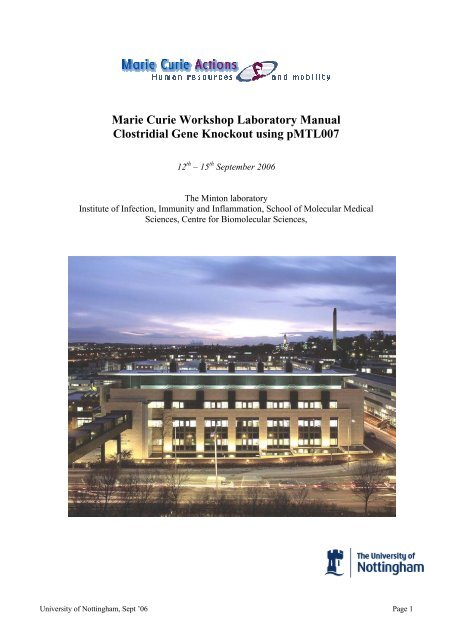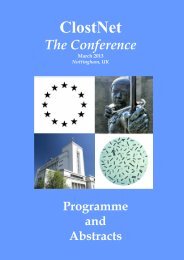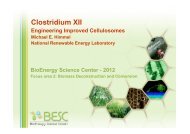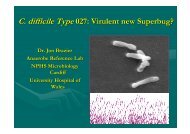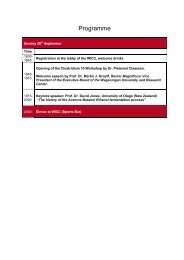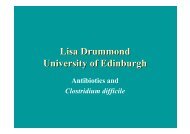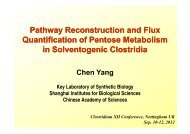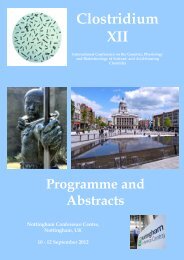Marie Curie Workshop Laboratory Manual Clostridial Gene ...
Marie Curie Workshop Laboratory Manual Clostridial Gene ...
Marie Curie Workshop Laboratory Manual Clostridial Gene ...
- No tags were found...
You also want an ePaper? Increase the reach of your titles
YUMPU automatically turns print PDFs into web optimized ePapers that Google loves.
<strong>Marie</strong> <strong>Curie</strong> <strong>Workshop</strong> <strong>Laboratory</strong> <strong>Manual</strong><strong>Clostridial</strong> <strong>Gene</strong> Knockout using pMTL00712 th – 15 th September 2006The Minton laboratoryInstitute of Infection, Immunity and Inflammation, School of Molecular MedicalSciences, Centre for Biomolecular Sciences,University of Nottingham, Sept ’06 Page 1
Event 2<strong>Marie</strong> <strong>Curie</strong> Training Conferences and <strong>Workshop</strong>s on ClostridiaContract: CLOSTRIDIA (SCF-CT-2005-029958)CLOSTRIDIA is an EU <strong>Marie</strong> <strong>Curie</strong>-funded series of Conferences and <strong>Workshop</strong>swhich seeks to educate and inform young European scientists on the biology ofmembers of the genus Clostridium and the diseases they cause. The series of Eventsare designed to encourage young researchers to combine the knowledge frommolecular microbiology and genomics with human and veterinary clinical aspects.The goal is to:• elevate European clostridial research to the international forefront;• establish long-term research synergies within the EU;• encourage young scientists to enter the field, and;• increase mobility & improve the career opportunities.Further information and links to conferences at www.clostridia.netPartners:Nigel P Minton - (Co-ordinator) Institute of Infection, Immunity &Inflammation, University of Nottingham, UKMaja Rupnik - Medical Faculty, University of Maribor, Maribor,SloveniaPaola Mastrantonio - Department of Infectious Parasitic and ImmunemediatedDiseases Istituto Superiore di Sanità, Rome,ItalyMiia Lindström - Faculty of Veterinary Medicine, University of Helsinki,Helsinki, FinlandRichard W Titball - Department of Biomedical Sciences, Defence Scienceand Technology <strong>Laboratory</strong>, Porton Down, UKPhilippe Soucaille - National Institute of Applied Sciences, Toulouse,FranceWolfgang Liebl - Institute of Microbiology and <strong>Gene</strong>tics, University ofGöttingen, GermanyUniversity of Nottingham, Sept ’06 Page 2
FOREWORDIt is with great pleasure that I welcome you all to the University of Nottingham for the<strong>Workshop</strong> on <strong>Gene</strong> Transfer Techniques for Clostridia. In attendance are 13 Group 1eligible young scientists from seven different member states (Belgium, Finland,France, Germany, Italy, The Netherlands and the UK) together with 3 Group 2 youngscientists from Greece, Poland and Portugal. This wide ranging national balanceshould create a fertile environment for forging new transnational collaborations.I am particularly grateful to our two Expert Tutors, Dr Peter Mullany (Eastman DentalInstitute, University College London) and Professor Mike Young (Institute ofBiological Sciences, University of Wales, Aberystwyth) who have generously givenup their time to help run this training course. Both are leaders in the field, and havepioneered many of the developments made to date within the arena of clostridial genesystems.I am also indebted to the Clostridia Research Group at the University of Nottingham,without whom this event would not be taking place. Special thanks are reserved forStephen Cartman, but most of all to John Heap for his tireless efforts in bringing thisworkshop to fruition.Nigel P MintonUniversity of Nottingham9 th September 2006University of Nottingham, Sept ’06 Page 3
ContentsProgramme – page 5Overview of practical sessions – page 7Protocol for Tuesday 12 th – page 8Protocol for Wednesday 13 th – page 13Protocol for Thursday 14 th – page 16Protocol for Friday 15 th – page 18Attendees – page 23Health & Safety – page 24University of Nottingham, Sept ’06 Page 4
ProgrammeMonday 11 th September – Arrival, Hugh Stewart Hall of Residence20.00 – 24.00 Welcome Get Together – University Staff ClubTuesday 12 th September07.00 – 07.45 Breakfast – Hugh Stewart Hall08.00 – 08.05 Welcome – Nigel Minton, Room B02, CBS08.05 – 09.00 Safety Induction – Room B02, CBS09.00 – 10.30 Practical Course – Room B39, CBS10.30 – 10.50 Coffee Break – Room B02, CBS10.50 – 13.00 Practical Course – Room B39, CBS13.00 – 14.00 Lunch – Room B02, CBS14.00 – 15.30 Practical Course – Room B39, CBS15.30 – 15.50 Coffee Break – Room B02, CBS14.00 – 18.00 Practical Course – Room B39, CBS20.00 – late Dinner – Red Hot Buffet Shack, Nottingham City CentreWednesday 13 thSeptember08.00 – 08.45 Breakfast – Hugh Stewart Hall09.00 – 11.00 Practical Course – Room B39, CBS11.00 – 11.20 Coffee Break – Room B02, CBS11.20 – 13.00 Introductory Lecture and primer design tutorialNigel P Minton & John Heap – Room B02, CBS13.00 – 14.00 Lunch – Room B02, CBS14.00 – 14.45 Seminar – “Conjugative gene transfer in saccharolyticClostridia” – Mike Young – Room B02, CBS14.45 – 15.30 Seminar – “Mobile genetic elements from C. difficile”Peter Mullany – Room B02, CBS15.30 – 15.50 Coffee Break – Room B02, CBS15.50 – 17.00 Practical Course – Room B39, CBS20.00 – late Dinner – Zizzi’s, Nottingham City CentreUniversity of Nottingham, Sept ’06 Page 5
Thursday 14 th September08.00 – 08.45 Breakfast – Hugh Stewart Hall09.00 – 11.00 Practical Course – Room B39, CBS11.00 – 11.30 Coffee Break – Room, CBS11.30 – 12.30 Seminar – “Use of conjugative transposons for the geneticmanipulation of C. difficile” – Peter Mullany – Room B02, CBS12.30 – 13.30 Lunch – Room B02, CBS13.30 – 14.30 Practical Course – Room B39, CBS14.30 – 15.30 Seminar – “How is Spo0A phorphorylated in clostridia?”Mike Young – Room B02, CBS15.30 – 16.00 Coffee Break – Room B02, CBS16.00 – 18.00 Practical Course – Room B39, CBS20.00 – late Dinner – Bistro Pierre, Nottingham City CentreFriday 15 th September08.00 – 08.45 Breakfast – Hugh Stewart Hall09.00 – 11.00 Practical Course – Room B39, CBS11.00 – 11.30 Coffee Break – Room B02, CBS11.30 – 13.00 Practical Course – Room B39, CBS13.00 – 14.00 Lunch – Room B02, CBS14.00 – 15.30 Practical Course – Room B39, CBS15.30 – 16.00 Coffee Break – Room B02, CBS16.00 – 17.00 ‘Wash-up’ (<strong>Gene</strong>ral Discussion. Future Developments)Nigel Minton – Room B02, CBS20.00 – late Farewell Party – Scruffy’s, Nottingham City CentreSaturday 16 th SeptemberDepartureUniversity of Nottingham, Sept ’06 Page 6
Overview of practical sessionsDuring this workshop, full instruction in the use of pMTL007 to generate clostridialgene knock-outs will be provided. All the major laboratory procedures will be taughtin practical sessions (described in this manual). The minor computational elements ofthe process are described in lectures or in this manual.<strong>Clostridial</strong> gene knock-out using the pMTL007 plasmid is typically completed in 10laboratory days. Only a few of these require a full day of laboratory work, and onmany there are only a few minutes of laboratory work to perform.The instructions in this manual are adapted from the ‘Protocol for <strong>Clostridial</strong> <strong>Gene</strong>Knockout using pMTL007’, which details in full how to perform clostridial geneknock-out using the pMTL007 plasmid. A copy of this Protocol is provided, andshould be kept to hand in the laboratory during the practical sessions.This manual refers to Days 1, 4, 5, 6, 7 and 10 of the Protocol.Tuesday 12 th September• Day 1 – Re-target pMTL007.• Day 4 – Prepare to conjugate target organisms.Wednesday 13 th September• Day 5 – Conjugate target organisms (Clostridium difficile and Clostridiumsporogenes).• Day 6 – Start overnight cultures of transconjugants and transformants.Thursday 14 th September• Day 7 – Induce target gene knockout.Friday 15 th September• Day 10 – Confirm knockout of target genes by PCR screening.• Inspect plates and interpret results.Rich complex media are suitable for all stages of the gene knockout protocol usingpMTL007. The following media will be used throughout the workshop:StrainMediaClostridium difficile – BHIClostridium sporogenes – TYGClostridium acetobutylicum – CGMUniversity of Nottingham, Sept ’06 Page 7
Tuesday 12 th SeptemberTODAYPerform the entire Day 1 protocol.From the Day 4 protocol – generate conjugation donor strains for Clostridium difficileand Clostridium sporogenes (the demonstrators will start overnight cultures of theappropriate conjugation recipient strains).Day 1 – Re-target pMTL007Perform Re-targeting PCR1. Assemble four-primer mixtureA pre-prepared four-primer mixture will be provided including the appropriate IBS,EBS1d and EBS2 primers to re-target the intron to insert in the antisense orientationat position 178/179 of the spo0A gene in Clostridium difficile 630∆Erm. See the‘Protocol for <strong>Clostridial</strong> <strong>Gene</strong> Knockout using pMTL007’ for details.EBS Universal:CGAAATTAGAAACTTGCGTTCAGTAAACCd-spo0A-178a-IBS:AAAAAAGCTTATAATTATCCTTATTATTCCATCTAGTGCGCCCAGATAGGGTGCd-spo0A-178a-EBS1d:CAGATTGTACAAATGTGGTGATAACAGATAAGTCCATCTAGTTAACTTACCTTTCTTTGTCd-spo0A-178a-EBS2:TGAACGCAAGTTTCTAATTTCGGTTAATAATCGATAGAGGAAAGTGTCT2. Assemble PCR reactionAssemble the PCR reaction on ice as follows:25 µl JumpStart REDTaq ReadyMix(provided pre-aliquotted into a PCR tube)23 µl Water1 µl Intron PCR Template1 µl Four-primer mix for Cdi-spo0A-178a targeting-region50 µl Total reaction volumeUniversity of Nottingham, Sept ’06 Page 8
3. Perform PCR using the following cycling conditions:Denature 94°C for 30 secondsDenature 94°C for 15 secondsAnneal 55°C for 30 seconds 30 cyclesExtend 72°C for 30 secondsExtend 72°C for 2 minutesPause 4°CA lab thermocycler is already programmed with these cycling conditions.4. Visualise PCR products using agarose gel electrophoresisAdd 10µl of 6x loading dye to the PCR tube and mix.A lane in a 1% (w/v) agarose gel will be provided.Load 25µl of your PCR product into one gel lane as directed by the demonstrators.5. Purify the ~350bp PCR productPurify the desired PCR product DNA using the Qiagen QIAquick Gel Extraction Kit:1. Excise the DNA fragment from the agarose gel with a clean, sharp scalpel.2. Weigh the gel slice in a colorless tube. Add 3 volumes of Buffer QG to 1volume of gel (100 mg ~ 100 µl).For example, add 300 µl of Buffer QG to each 100 mg of gel. The maximumamount of gel slice per QIAquick column is 400 mg; for gel slices >400 mguse more than one QIAquick column.3. Incubate at 50°C for 10 min (or until the gel slice has completelydissolved). To help dissolve gel, mix by vortexing the tube every 2–3 minduring the incubation.IMPORTANT: Solubilize agarose completely.4. Add 1 gel volume of isopropanol to the sample and mix.For example, if the agarose gel slice is 100 mg, add 100 µl isopropanol. Thisstep increases the yield of DNA fragments 4 kb. Do notcentrifuge the sample at this stage.5. Place a QIAquick spin column in a provided 2 ml collection tube.6. To bind DNA, apply the sample to the QIAquick column, and centrifugefor 1 min.The maximum volume of the column reservoir is 800 µl. For sample volumesof more than 800 µl, simply load and spin again.7. Discard flow-through and place QIAquick column back in the samecollection tube.8. Add 0.5 ml of Buffer QG to QIAquick column and centrifuge for 1 min.This step will remove all traces of agarose.9. To wash, add 0.75 ml of Buffer PE to QIAquick column and centrifugefor 1 min.10. Discard the flow-through and centrifuge the QIAquick column for anadditional 1 min at 13,000 rpm (~17,900 x g).11. Place QIAquick column into a clean 1.5 ml microcentrifuge tube.12. To elute DNA, add 30 µl of Buffer EB to the centre of the QIAquickmembrane, let the column stand for 1 min, and then centrifuge for 1 min.University of Nottingham, Sept ’06 Page 9
Label the tube containing the purified PCR product, and place it on ice.Restriction digestion of the PCR product and pMTL007 plasmid DNA1. Digest PCR product and pMTL007 with HindIII and BsrGIYou only need to digest your gel-purified PCR product (you will be provided with apre-prepared aliquot of pMTL007 linearised with HindIII and BsrGI).Assemble the restriction digestion reaction mixture as follows, adding the restrictionenzymes last:8 µl Purified PCR product DNA2 µl 10x Restriction Enzyme Buffer1 µl HindIII (20U/µl)1 µl BsrGI (10U/µl)8 µl Water20 µl Total reaction volumeIncubate the reaction at 37°C for 30 minutes then 60°C for 30 minutes.2. Analyse pMTL007 restriction digestion using agarose gel electrophoresisThis step has already been performed by the demonstrators.3. Purify the digested PCR productPurify the new targeting region from the digestion of the PCR product using theQiagen QIAquick Gel Extraction Kit:1. Add 5 volumes of Buffer PB to 1 volume of the reaction mixture and mix.For example, add 100 µl of Buffer PB to 20 µl reaction mixture sample.2. Place a QIAquick spin column in a provided 2 ml collection tube.3. To bind DNA, apply the sample to the QIAquick column, and centrifugefor 1 min.4. Discard flow-through and place QIAquick column back in the samecollection tube.5. To wash, add 0.75 ml of Buffer PE to QIAquick column and centrifugefor 1 min.6. Discard the flow-through and and place the QIAquick column back in thesame tube. Centrifuge the QIAquick column for an additional 1 min at13,000 rpm (~17,900 x g).7. Place QIAquick column into a clean 1.5 ml microcentrifuge tube.8. To elute DNA, add 30 µl of Buffer EB to the centre of the QIAquickmembrane, let the column stand for 1 min, and then centrifuge for 1 min.University of Nottingham, Sept ’06 Page 10
Ligation of the digested PCR product into pMTL0071. Assemble the ligation reaction mixturesSet up a ligation reaction and a vector-only control ligation reaction.Assemble the ligation reaction mixtures as follows, adding the ligase enzyme last:1 µl Digested pMTL007 vector5 µl Digested PCR product or water1 µl 10x ligase buffer (New England Biolabs)0.5 µl Ligase (New England Biolabs)2.5 µl Water10 µl Total reaction volume2. Incubate the reaction mixtures to allow ligation to occurIncubate the ligation reactions at room temperature for 30 minutes.NOTE – the Day 1 and Day 4 transformations should be performed at the same timeTransform ligation reactions into E. coli cloning strain1. Transform competent E. coli TOP10 cells by electroporation1. Dialyse the ligation reaction mixtures against distilled water for 15-30 minutesto remove salt.2. Add all of each dialysed ligation reaction mixture to an aliquot (~50µl) ofelectro-competent cells, and stir gently with the pipette tip.3. Incubate the mixtures on ice for 5 minutes.4. Transfer the mixtures into chilled 0.2cm gap electroporation cuvettes.5. Electroporate the cells using a BioRad Micropulser set to program ‘Ec2’.6. Immediately add 250µl room-temperature 2xYT recovery medium.7. Transfer the suspension into 1.5ml microcentrifuge tube.8. Incubate the transformation mixture at 37°C and 200rpm shaking for one hourto allow expression of the antibiotic resistance gene.2. Select for transformed cells using chloramphenicolSpread 100µl of neat and 10-fold diluted ligation reaction transformants onto 2xYTplates supplemented with 25 µg/ml chloramphenicol. Spread 100µl of neat vectoronlycontrol ligation reaction transformants onto another plate of the same type. Thedemonstrators will incubate the plates at 37°C overnight.University of Nottingham, Sept ’06 Page 11
Day 4 – Prepare to conjugate target organismsYou will generate conjugal donor strains to conjugate Clostridium difficile 630∆Ermand Clostridium sporogenes 10696.Re-transform plasmid DNA into an appropriate E. coli conjugation donor strainsuch as CA434 and inoculate an overnight culture with the transformantsYou will be provided with one (not both) of the following re-targeted pMTL007plasmids which have already been verified by sequencing:pMTL007::Cdi-spo0A-178a (Targets the spo0A gene inClostridium difficile 630∆Erm)pMTL007::Csp-spo0A-249s (Targets the spo0A gene inClostridium sporogenes 10696)The plasmids must be transformed into E. coli CA434 cells to generate conjugaldonor strains which can be used to transfer the re-targeted pMTL007 plasmids into thetarget clostridial strains by conjugation.Each group will only generate one conjugal donor strain, but other groups willgenerate the other conjugal donor strain, so cultures of both required strains will beavailable on Wednesday morning.1. Transform competent E. coli CA434 cells by electroporationTransform the re-targeted pMTL007 plasmid into an aliquot of electro-competent E.coli CA434 cells. Use the electroporation protocol as described on the previous page,except:Add 1µl of the plasmid DNA solution to the aliquot of electro-competent E.coli CA434 cells.Dialysis of the plasmid DNA is not required.2. Inoculate the transformed cells directly into an overnight cultureAfter the one hour recovery period, add the transformation mixture directly into 5 mlof LB broth supplemented with 12.5 µg/ml chloramphenicol. The demonstrators willincubate the culture at 37°C and 200rpm shaking overnight.University of Nottingham, Sept ’06 Page 12
Wednesday 13 th SeptemberTODAYPerform the entire Day 5 protocol for Clostridium difficile and Clostridiumsporogenes. Due to time and space constraints, the demonstrators will perform theDay 5 protocol for Clostridium acetobutylicum.From the Day 6 protocol – start overnight cultures of pMTL007 transconjugants ortransformants of Clostridium sporogenes and Clostridium acetobutylicum.Day 5 – Conjugate target organisms (Clostridium difficile andClostridium sporogenes)Mix conjugal donors and recipients and incubate on a plate for 4-8hrs to allowtransfer of pMTL007 by conjugation1. Pellet and wash conjugal donor cellsPipette 1ml of each of the stationary overnight cultures of the two conjugation donorstrains into 1.5ml microcentrifuge tubes. Pellet by centrifugation at 8000rpm for 1minute.The two conjugation donor strains are E. coli CA434 cells containing:pMTL007::Cdi-spo0A-178a (Targets the spo0Agene inClostridium difficile 630∆Erm)orpMTL007::Csp-spo0A-249s (Targets the spo0A gene inClostridium sporogenes 10696)Discard the supernatant, then wash the pellets by re-suspending each in 0.5ml ofsterile PBS. Centrifuge as before and discard the supernatant.With a demonstrator, take the two microcentrifuge tubes containing the washedconjugation donor strain cell pellets into an anaerobic cabinet.2. Mix conjugal donors and recipientsRe-suspend the conjugal donor pellets in 200µl of a stationary overnight culture of theappropriate conjugal recipient cells:pMTL007::Cdi-spo0A-178a – Clostridium difficile 630∆ErmpMTL007::Csp-spo0A-249s – Clostridium sporogenes 106963. ‘Spot’ and incubate conjugation mixturePipette the entire of each conjugation mixture onto a single non-selective platecontaining an appropriate anaerobic solid growth medium in discrete drops or ‘spots’.University of Nottingham, Sept ’06 Page 13
Do not invert the plate. Incubate the plate at in the anaerobic cabinet for 4-8hrs toallow conjugal transfer of the re-targeted pMTL007 plasmid from the E. coli donor tothe clostridial recipient.During the incubation step:11:00 – 11:20 Coffee break11:20 – 13:00 Introductory lecture and primer design tutorial13:00 – 14:00 Lunch14:00 – 14:45 Seminar14:45 – 15:30 Seminar15:30 – 15:50 Coffee breakPlate transconjugants onto selective growth medium and incubate overnight1. Wash conjugation mixture off conjugation platePipette 1ml of anaerobic sterile PBS onto the conjugation plate. Using a sterilespreader, scrape the layer of cells off the plate and re-suspend them in the PBS.2. Spread conjugation slurry onto selective plates and incubateUsing a pipette, aspirate as much of the conjugation slurry as possible into a freshmicrotube. Spread 100µl of the neat and 100µl of the 10-fold diluted slurry onto freshplates containing an appropriate anaerobic solid growth medium, supplemented with250µg/ml cycloserine to select against the E. coli conjugal donor and 15µg/mlthiamphenicol to select for the re-targeted pMTL007 plasmid.Invert the plates and incubate in the anaerobic cabinet for 1-3 days.Day 6 – Start overnight cultures of transconjugants andtransformantsDue to limited time available during this workshop, we cannot wait for thetransformants and transconjugants you have generated to grow. For this reason thedemonstrators have prepared the appropriate transformants and transconjugants foryou.Inoculate overnight cultures of Clostridium sporogenes transconjugants andClostridium acetobutylicum transformantsInoculate overnight cultures in 1ml of an appropriate anaerobic liquid growth mediumsupplemented with 7.5µg/ml thiamphenicol using transformants from the platesprovided:Clostridium sporogenes 10696 containing pMTL007::Csp-spo0A-249sandClostridium acetobutylicum ATCC824 containing pMTL007::Cac-spo0A-242aUniversity of Nottingham, Sept ’06 Page 14
The thiamphenicol will select for the re-targeted pMTL007 plasmid.Incubate the cultures incubate in the anaerobic cabinet overnight.Note:In some organisms (such as Clostridium difficile) pMTL007 is very unstable, andcannot easily be maintained in liquid culture. For such organisms, an alternativeprotocol for Day 7 is available, and an overnight culture is not required.University of Nottingham, Sept ’06 Page 15
Thursday 14 th SeptemberTODAYPerform the entire Day 7 protocol for Clostridium difficile, Clostridium sporogenesand Clostridium acetobutylicum.Day 7 – Induce target gene knockoutInoculate fresh selective broth with transconjugants and transformantsInoculate 1ml broths of appropriate anaerobic liquid growth media (supplementedwith 7.5µg/ml thiamphenicol to select for the re-targeted pMTL007 plasmid) with thetransformants and transconjugants as shown:Strain Inoculum MediumClostridium sporogenes10696 containingpMTL007::Csp-spo0A-249sClostridium acetobutylicumATCC824 containingpMTL007::Cac-spo0A-242aClostridium difficile630∆Erm containingpMTL007:: Cdi-spo0A-178a100µl overnight culture TYG + 7.5µg/mlthiamphenicol100µl overnight culture CGM + 7.5µg/mlthiamphenicol1 or 2 loops of cells BHI + 7.5µg/mlthiamphenicolNormally, these cultures are incubated at 37°C under anaerobic conditions until thereis visible growth, indicating the culture is in exponential phase (typically afterincubation for 1hr). However, to save time, we will omit this non-essential stepduring the workshop.Induce intron expression with IPTGAdd 10µl of 100mM IPTG stock to each culture, resulting in final IPTGconcentrations of 1mM. Incubate the cultures in the anaerobic cabinet forapproximately 3hrs.During the IPTG induction step:11:00 – 11:30 Coffee break11:30 – 12:30 Seminar12:30 – 13:30 LunchUniversity of Nottingham, Sept ’06 Page 16
Wash cells and allow recovery periodPellet the cells by centrifugation at 8000rpm for 1 minute. Discard the supernatants,then wash the cells by re-suspending them in 0.5ml of sterile PBS. Centrifuge asbefore and discard the supernatants.Re-suspend each pellet in 1ml of an appropriate anaerobic liquid growth media,unsupplemented with antibiotics, and incubate in the anaerobic cabinet forapproximately 3hrs.During the recovery incubation step:14:30 – 15:30 Seminar15:30 – 16:00 Coffee breakPlate integrants onto selective growth medium and incubate overnightPlate the integration mixtures onto fresh plates containing an appropriate anaerobicsolid growth medium supplemented with 2.5µg/ml erythromycin to select for presenceof the spliced ErmRAM, which indicates intron integration. Spread three plates with100µl of neat, 100µl of 100-fold diluted and 100µl of 5-fold concentrated integrationmixture.To determine the frequency of the integration event, serially-dilute each integrationmixture to 10 -4 , 10 -5 , 10 -6 and 10 -7 in 1.5ml tubes. Pipette 3x20µl drops of each of the10 -4 , 10 -5 , 10 -6 and 10 -7 dilutions onto one quarter of an appropriate plateunsupplemented with antibiotics. Do not invert the plates.Strain Selective medium Non-selective mediumClostridium sporogenes 10696spo0A knock-outsClostridium acetobutylicum ATCC824spo0A knock-outsClostridium difficile 630∆Ermspo0A knock-outsTYG + 2.5µg/mlerythromycinCGM + 2.5µg/mlerythromycinBHI + 2.5µg/mlerythromycinTYGCGMBHIIncubate the plates in the anaerobic cabinet until the end of the workshop.University of Nottingham, Sept ’06 Page 17
Friday 15 th SeptemberTODAYPerform the PCR screening from the Day 10 protocol for the Clostridiumacetobutylicum ATCC824 spo0A knock-out strain.Day 10 – Confirm knockout of target genes by PCR screeningPrepare genomic DNA from overnight culturesThe demonstrators have pre-prepared genomic DNA from the Clostridiumacetobutylicum ATCC824 spo0A knock-out strain.Use PCR to screen colonies for the desired integration eventPCRs using several different combinations of primers can be used to characterise theintron integants, as shown in figure 1.Figure 1 PCR screening for desired integrantsThe yellow arrows represent the Ll.LtrB group II intron, the blue arrows represent the ermBderivedmarker, the grey arrow represents the group I intron and the red arrows represent thedisrupted Clostridium acetobutylicum ATCC824 spo0A gene. PCR primers are shown asblack half-arrows.(A) represents the pMTL007::Cac-spo0A-242a plasmid DNA(B) represents chromosomal DNA in which the target gene has been disrupted by the insertionof an intron in the sense orientation relative to the target gene.We will demonstrate intron insertion and disruption of the desired target gene usingtwo diagnostic PCR screens:PCR screen Primers AmplifiesRXErmRAM-F +ErmRAM-REBS Universal +Cac-spo0A-RSpliced RAM in integrated intron and/orfull-length RAM from pMTL007Across intron-exon junction only if the isintron inserted into the spo0A geneGenomic DNA from wild-type Clostridium acetobutylicum ATCC824 andpMTL007::Cac-spo0A-242a plasmid DNA will be used as control templates.University of Nottingham, Sept ’06 Page 18
1. Label PCR tubesLabel 8 PCR tubes with the numbers 1-8 and your group’s letter.For example, A1, A2, A3… A8.2. Assemble PCR reaction master mixesAssemble the PCR reaction ‘R’ master mix in tube number 1 on ice as follows, addingthe Failsafe enzyme last:50 µl 2x Failsafe Premix buffer E43 µl Water1 µl ErmRAM-F primer (100µM)1 µl ErmRAM-R primer (100µM)1 µl Failsafe enzyme96 µl Total master mix volumeAssemble the PCR reaction ‘X’ master mix in tube number 5 on ice as follows,adding the Failsafe enzyme last:50 µl 2x Failsafe Premix buffer E43 µl Water1 µl EBS Universal primer (100µM)1 µl Cac-spo0A-R primer (100µM)1 µl Failsafe enzyme96 µl Total master mix volume3. Divide PCR reaction master mixesMix the PCR reaction master mixes by gently pipetting up and down.Divide master mix ‘R’ among tubes 1-4 (24µl in each tube).Divide master mix ‘X’ among tubes 5-8 (24µl in each tube).Return all tubes to ice.4. Add PCR templatesAdd 1µl of PCR templates to the tubes as follows:TemplateTubesWater 1 + 5Genomic DNA from wild-typeClostridium acetobutylicum ATCC8242 + 6pMTL007::Cac-spo0A-242a plasmid DNA 3 + 7Genomic DNA from theClostridium acetobutylicum ATCC824 4 + 8spo0A knock-outUniversity of Nottingham, Sept ’06 Page 19
5. Perform PCR using the following cycling conditions:Denature 94°C for 30 secondsDenature 94°C for 30 secondsAnneal 50°C for 30 seconds 30 cyclesExtend 72°C for 1 minute and 20 secondsExtend 72°C for 7 minutesPause 4°CA lab thermocycler is already programmed with these cycling conditions.During the PCR thermocycling, inspect plates from experiments on previous days.6. Visualise PCR products using agarose gel electrophoresisAdd 5µl of 6x loading dye to each PCR tube and mix.Lanes in a 1% (w/v) agarose gel will be provided.Load 15µl of each of the PCR products into gel lanes as directed by thedemonstrators, in sequence 1-8.During the gel electrophoresis, inspect plates from experiments on previous days.7. Interpret PCR screen ‘R’Refer to figure 1 to help you interpret PCR screen ‘R’.The spliced RAM in the integrated intron is approximately 900bp in length. A PCRproduct of this size indicates the presence of integrated intron DNA.The full-length RAM from pMTL007 is approximately 1300bp in length. A PCRproduct of this size indicates the presence of pMTL007 plasmid DNA.8. Interpret PCR screen ‘X’Refer to figure 1 to help you interpret PCR screen ‘X’.The EBS Universal primer anneals 219bp from the 5’ end of the intron on the reversestrand. The Cac-spo0A-R primer anneals at the end of the spo0A ORF, 604bpdownstream of the intron insertion site. This pair of primers should therefore amplifya PCR product across the intron-exon junction of approximately 823bp in length, onlyif the intron has inserted into the desired site in the spo0A gene.University of Nottingham, Sept ’06 Page 20
Inspect plates and interpret resultsRe-targeted pMTL007 ligation platesAt the bench, inspect the re-targeted pMTL007 ligation plates and vector-only controlligation plate.There should be numerous colonies on the re-targeted pMTL007 ligation plates andvery few or ideally no colonies on the vector-only control plate.Any colonies on the vector-only control plate must have been transformed with recircularisedpartially-digested pMTL007 vector. A similar number of coloniescontaining re-circularised vector should be expected on the corresponding re-targetedpMTL007 ligation plate.Note:The linearised pMTL007 vector was purified by gel-extraction, but was not treatedwith alkaline phosphatase. Alkaline phosphatase treatment will greatly reduce recircularisationof partially-digested pMTL007 vector.Clostridium difficile and Clostridium sporogenes conjugation plates andClostridium acetobutylicum transformation platesIn the anaerobic cabinet, inspect the Clostridium difficile and Clostridium sporogenesconjugation plates and Clostridium acetobutylicum transformation plates.The Clostridium sporogenes transconjugants should have formed numerous largecolonies by now.The Clostridium difficile transconjugants may be visible, but any colonies are likely tobe small after two days’ incubation. The fewer colonies and their smaller size thanthe equivalent Clostridium sporogenes transconjugants reflects the lower stability ofthis plasmid in Clostridium difficile.The Clostridium acetobutylicum transformants may be visible, but any colonies arelikely to be small after two days’ incubation. Transformation of Clostridiumacetobutylicum is an inefficient process, and only a small number of colonies can beexpected.Clostridium difficile, Clostridium sporogenes and Clostridium acetobutylicumintegrant (knock-out mutant) plates and controlsIn the anaerobic cabinet, inspect the Clostridium difficile, Clostridium sporogenes andClostridium acetobutylicum integrant (knock-out mutant) plates and controls.Count or estimate the numbers of colonies on the erythromycin-supplemented plates.Colonies of Clostridium difficile and Clostridium acetobutylicum integrants should bevisible, but colonies of Clostridium sporogenes integrants will probably not be visibleafter less than 24hrs incubation. Calculate the number of erythromycin-resistantcfu/ml that were in the integration mixture.University of Nottingham, Sept ’06 Page 21
For each integration experiment:Identify which dilution of the integration mixture gave between 5 and 50 colonies per20µl drop on the unsupplemented control plates. Count the number of colonies ineach drop, and calculate the average number per drop. Multiply the average numberof colonies per 20µl drop by 50 and by the appropriate dilution factor to determine thenumber of cfu/ml that were in the integration mixture.Calculate the intron integration frequencies:Frequency as % = erythromycin-resistant cfu/ml x 100total cfu/mlUniversity of Nottingham, Sept ’06 Page 22
PARTICIPANTSSURNAME FIRST NAME INSTITUTE EMAILTuteesTimbermont Leen Ghent University Belgium leen.timbermont@ugent.beSoderholm Henna University of Helsinki Finland henna.soderholm@helsinki.fiAntunes Ana Institute Pasteur, Paris France antunes@pasteur.frBlouzard Jean-Charles CNRS BIP, Marseille France blouzard@ibsm.cnrs-mrs.frDeneve Cecile University Paris de Sud France cecile.deneve@cep.u-psud.frMeisohle Dominik University of Ulm Germany dominik.meisohle@gmx.deReibe Oliver University of Rostock Germany oliver.riebe@uni-rostock.deNisiotou Aspasia University of Athens Greece anisiotou@aua.grBarbanti FabrizioNational Institute ofHealth, RomeItalyfbarbant@hotmail.comMengeshaWoldemicael Asferd University of MaastrictThe Netherlandsasferd.mengesha@maastro.unimaas.nlSiemerink Marco Wageningen University The Netherlands marco.siemerink@wur.nlKuit Wouter Wageningen University The Netherlands wouter.kuit@wur.nlRomanik Malgorzata University of Silesia Poland mikrobiologia@slam.katowice.plIsidro Anabela University of Lisbon Portugal aisidro@itqb.unl.ptUnderwood Sarah University of Leeds United Kingdom bmbsu@leeds.ac.ukWroe Allison University of Edinburgh United Kingdom s0232906@sms.ed.ac.ukTutorsMinton Nigel University of Nottingham United Kingdom nigel.minton@nottingham.ac.ukMullany Peter Eastman Institute, UCL United Kingdom pmullany@eastman.ucl.ac.ukYoung MikeUniversity of Wales,AberystwythUnited Kingdommiy@aber.ac.ukDemonstratorsCartman Stephen University of Nottingham United Kingdom stephen.cartman@nottingham.ac.ukCooksley Clare University of Nottingham United Kingdom paxcmc1@nottingham.ac.ukDavis Ian University of Nottingham United Kingdom ian.davis@nottingham.ac.ukHeap John University of Nottingham United Kingdom paxjth@nottingham.ac.ukPennington Oliver University of Nottingham United Kingdom oliver.pennington@nottingham.ac.ukScott Jamie University of Nottingham United Kingdom paxjcs@nottingham.ac.ukSecretariatMinton Jacqueline University of Nottingham United Kingdom jacqueline.minton@nottingham.ac.ukUniversity of Nottingham, Sept ’06 Page 23
Centre for Biomolecular Sciences<strong>Marie</strong> <strong>Curie</strong> <strong>Workshop</strong>September, 2006Health and Safety InformationUniversity of Nottingham, Sept ’06 Page 24
IntroductionThe Centre for Biomolecular Sciences is a multi-disciplinary centre, bringing togetherresearchers from a wide range of different Schools and disciplines. A fundamentalreason for this venture is to create new collaborations between these disciplines andgroups, so that they can work together to take biomolecular research into exciting andfruitful new directions. An essential part of this process is ensuring the health andsafety of all of the staff, students and visitors working in the CBS. This guideprovides you with the basic health and safety information which you will need duringyour course at CBS. Specific health and safety information for the laboratories andtechniques which you will be using will be provided by the course tutors.SmokingSmoking is not permitted anywhere in the CBSAccess to CBSYou will normally be allowed access to CBS under the supervision of a CourseTutor between:0700 to 1900Access through the front door will be provided by the receptionist or a Course Tutor.You will be required to sign in and out of the building at Reception.When judged necessary by the Course Tutor, you will be allowed to remain in thebuilding under their supervision up to2145The building alarms activate automatically and the doors are locked at2200You must leave the building before that time.You will be issued with a key code to allow access to B floorDo not allow anyone else who is not known to you as authorised to enter CBS to gointo the building with you.University of Nottingham, Sept ’06 Page 25
Public and circulation areasMembers of the public and visitors will use the atrium area, passenger lift and mainstairwell. It is important that they are not put at risk. For that reason, hazardoussubstances and general laboratory equipment must not be brought into the areas, evenin transit. <strong>Laboratory</strong> coats and other personal protective equipment should also notbe worn when you are in these areas.Staff and students moving between laboratories on different floors should use thestairway at the northern end of the building and the goods lift for moving materialsand equipment between floors.The movement of hazardous materials between laboratories and floors should beavoided whenever possible. When this is necessary, the items must be securelycontained.Evacuation AlarmThis is a single, continuous tone[The alarm is tested on Wednesday morning at 1140 for about one minute. If it lastslonger than this, you should evacuate the building]In the event of a fireIf you discover a fire:• Go to a fire alarm point and activate the alarm system• If practicable, dial 8888 on the nearest internal telephone and inform Security ofthe location of the fire.• Walk out in an orderly manner via the nearest exit or fire exit, closing (notlocking) all doors behind you. Do not stop to collect personal belongings.• Do not use lifts.• Move away from the entrance to the building and assemble at the assembly pointin front of the Boots Building.University of Nottingham, Sept ’06 Page 26
If you hear the fire/evacuation alarm:Begin the evacuation• Do not stop to collect personal belongings.• Do not use lifts.• Move away from the entrance to the building and assemble at the assembly pointin front of the Boots Building.If practicable,• Switch off gas taps and live electrical devices and shut all windows as you leave,• Pull down the sash on fume hoods.In all cases,• Do not do anything that will hinder the work of the Fire Service or otheremergency services.• Do not attempt to return to the building until instructed that it is safe to do so bythe evacuation coordinator, identified by a high-visibility yellow jacket.FinalExitFinalExitAssemblyPoint inFront ofBootsScienceBuildingUniversity of Nottingham, Sept ’06 Page 27
First Aid• In the case of injury inform a Course Tutor or other member of staff, who willthen call for a First Aider or 8888 for an ambulance, if needed.• First Aid boxes are prominently located in each corridor. Beside these are listedthe names of trained First Aiders, their internal phone numbers and roomlocations. This information is also given below:Authorised First Room ExtensionAidersTrevor Wigham C16 68542Darren Furniss B12 67955Alan Cockayne B13 67956Saara Qazzi B27 67963Di Mitchell B7 67950Carole White C17 13416Lee Hibbett C17 13416Panos Soultanas A13 13525University of Nottingham, Sept ’06 Page 28
Good <strong>Laboratory</strong> PracticeWithin the laboratories of the CBS there is a wide range of chemical, biological,radiation and equipment-related hazards. Although a number of these will requirevery specific precautions, for many of them adhering to the following principles ofgood laboratory practice will provide good protection against the risks.You should always:1. Carry out a risk assessment or read the assessment provided before you startthe work and make sure you use the appropriate safety precautions identifiedby the assessment.2. Follow the appropriate written Standard Operating Procedure (SOP) for thework.3. Wear any personal protective equipment (e.g. lab coats, safety glasses, gloves)which is required for the work you are doing4. Tie long hair back securely at all times ,since it can be a hazard when usingboth chemicals and equipment. Do not use hair gels and lacquers when in thelaboratory, since they are often flammable5. Wear suitable foot wear, which encloses the whole foot, not sandals or opentoedshoes.6. Avoid wearing short skirts or shorts in laboratories using hazardous chemicals7. Keep the work area clean at all times and free from chemicals and apparatuswhich are not required8. Return all equipment not in use to its proper storage place9. Clean up after each stage of an experiment10. Keep the laboratory floor free from all obstructions; these form trippinghazards and can cause serious accidents11. Clean any spillage of chemicals and biological materials up immediately,using only the appropriate procedures for the spilled material12. Clearly and securely label all containers of chemicals and biological materials,including experimental glass and plastic ware with their contents andappropriate hazard warnings. Avoid using felt-tip pens directly onto glass; thisis easily removed by a wide range of common solventsUniversity of Nottingham, Sept ’06 Page 29
13 Follow the following rules to reduce the risk of contaminating your body withhazardous substancesooooooNever take food and drink into the laboratoryNever apply cosmetics, creams or ointments in the laboratory.Never inhale, taste or swallow any chemicalNever pipette liquids by mouth. Use a mechanical filler instead.Wash your hands regularly, especially before you leave the laboratoryto eat or drink or go to the toilet.Before leaving the lab on completion of your work remove your labcoat and hang on the hooks provided, then wash your hands. Do nothang your lab coat on top of others.14. Do not bring outdoor coats and personal bags into the laboratory;15. Hang lab coats which are not being used on the hooks provided; not on thebacks of chairs.16. Dispose of waste chemicals and biological materials carefully, following theappropriate proceduresUniversity of Nottingham, Sept ’06 Page 30
Waste DisposalAll hazardous biological waste must be inactivated by validated methods, such asautoclaving or disinfection, before being sent for incineration.Never put contaminate materials in the domestic waste bags or put contaminatedmedia down sinksThe general procedures in place for CBS are given overleafUniversity of Nottingham, Sept ’06 Page 31
Contaminated Biological WasteWaste Category Examples Disposal routeSolid wasteContaminated smallplasticsContaminated largeplasticstips, tubes andspreadersfalcon tubes‘sweetie’ jars, when full close,label with autoclave tape, place inautoclave bags and take to mediaprep for autoclaving.autoclave bags, when full close,label with autoclave tape, place inautoclave bags and take to mediaprep for autoclaving.Low-level contamination gloves, tissues yellow bags. When full place in thelarge yellow skip outside the mediaprep roomSolid growth media Petri dishes autoclave tins. When 2/3 full taketo media prep for autoclaving. Donot overfillLiquid growth mediaSmall volumes Eppendorfs sweetie jars. when full close, labelwith autoclave tape, place inautoclave bags and take to mediaprep for autoclaving.Larger volumesSterilins, falcontubes500ml Duran bottles. When 2/3full.Do not put chemical disinfectants(Trigene, etc) into thesecontainers as they can producehazardous vapours whenautoclavedGlass Universals orErlenmeyer flasksplace in dedicated boxes in lab.Cover open flasks with aluminiumfoil and secure with autoclave tape.Take full boxes to media prep forautoclavingDo not put chemical disinfectants(Trigene, etc) into thesecontainers as they can producehazardous vapours whenautoclavedUniversity of Nottingham, Sept ’06 Page 32
Mixed biological and chemical wasteWaste CategoryContaminated plasticsDisposal routesterilise chemically using Trigene or appropriatedisinfectant. Put into yellow bags for collection andincineration. DO NOT put mixed waste in autoclavebags due to the potential danger to the autoclaveoperative from chemical vapours.Contaminated glassware chemical sterilisation by immersion overnight in 1: 100Trigene solutions prior to washing. Inform the technicalstaff in the wash-up area of the nature of the mixedbiological/chemical hazard as they receive the glassware.Low-level contamination(gloves, tissues)Liquid growth mediayellow bags for collection and incinerationspeak to local safety monitors or the CSO for specificguidance on these routes.small volumes in an Eppendorf tube can be put into burnbins for incineration. It is always a good idea to put someform of absorbent material in burn bins that are expectedto contain liquid wasteLarger volumes (aspirants to traps, waste contained in amulti-well dish) should be separated from noncontaminatedchemical waste and processed followinglocally arranged routes considered in risk assessments.These should take account of methods to immobilise thechemical, the survival of the biological substance and theneed to inform others involved in the waste-processingroute.University of Nottingham, Sept ’06 Page 33
Contaminated glass and metal equipmentWaste Category Examples Disposal routeContaminated glasswareautoclave prior to washup;or chemicalsterilisation by immersionovernight in 1: 100Trigene solution.Contaminated metalequipmentdissecting instruments andmesh screensautoclave, or chemicalsterilisation by immersionovernight in 1: 10 TrigeneContaminated sharpsneedles, scalpel blades,microscope slidessolution.yellow "contaminatedsharps" waste bins forincineration. To avoidaccidental stabbing, Neverreplace the needle guardNote: Certain work areas may have specialised needs regarding waste-handling anddisposal. In such cases, local guidelines must be produce, which tailored to meet thespecific needs. Providing this information should form part of worker inductionwithin that work area.University of Nottingham, Sept ’06 Page 34


